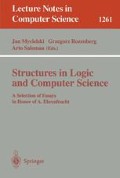Abstract
Because splicing systems with a finite set of rules generate only regular languages, it is necessary to supplement such a system with a control mechanism on the use of rules. One fruitful idea is to use distributed architectures suggested by the grammar systems area. Three distributed computability (language generating) devices based on splicing are discussed here. First, we improve a result about the so-called communicating distributed H systems (systems with seven components are able to characterize the recursively enumerable languages — the best result known up to now is of ten components), then we introduce two new types of distributed H systems: the separated two-level H systems and the periodically time-varying H systems. In both cases we prove characterizations of recursively enumerable languages — which means that in all these cases we can design universal “DNA computers based on splicing”.
Research supported by the Academy of Finland, Project 11281, and “NUFFIC: Cultural Cooperation between The Netherlands and Romania” Grant.
Preview
Unable to display preview. Download preview PDF.
References
E. Csuhaj-Varju, J. Dassow, J. Kelemen, Gh. Păun, Grammar Systems. A Grammatical Approach to Distribution and Cooperation, Gordon and Breach, London, 1994.
E. Csuhaj-Varju, L. Freund, L. Kari, Gh. Păun, DNA computing based on splicing: universality results, First Annual Pacific Symp. on Biocomputing, Hawaii, Jan. 1996.
E. Csuhaj-Varju, L. Kari, Gh. Păun, Test tube distributed systems based on splicing, Computers and AI, 15, 2–3 (1996), 211–231.
K. Culik II, T. Harju, Splicing semigroups of dominoes and DNA, Discrete Appl. Math., 31 (1991), 261–277.
J. Dassow, Gh. Păun, Regulated Rewriting in Formal Language Theory, Springer-Verlag, Berlin, Heidelberg, 1989.
J. Dassow, Gh. Păun, G. Rozenberg, Grammars systems, a chapter in vol. 2 of Handbook of Formal Languages (G. Rozenberg, A. Salomaa, eds.), Springer-Verlag, Heidelberg, 1997.
J. Dassow, Gh. Păun, A. Salomaa, Grammars with controlled derivations, a chapter in vol. 2 of Handbook of Formal Languages (G. Rozenberg, A. Salomaa, eds.), Springer-Verlag, Heidelberg, 1997.
R. Freund, L. Kari, Gh. Păun, DNA computing based on splicing: The existence of universal computers, Technical Report 185-2/FR-2/95, TU Wien, 1995.
T. Head, Formal language theory and DNA: an analysis of the generative capacity of specific recombinant behaviors, Bull. Math. Biology, 49 (1987), 737–759.
T. Head, Gh. Păun, D. Pixton, Language theory and molecular genetics. Generative mechanisms suggested by DNA recombination, a chapter in vol. 2 of Handbook of Formal Languages (G. Rozenberg, A. Salomaa, eds.), Springer-Verlag, Heidelberg, 1996.
Gh. Păun, Grammar systems. A grammatical approach to distribution and cooperation, ICALP 1995, LNCS 944 (Z. Fulop, F. Gecseg, eds.), Springer-Verlag, 1995, 429–443.
Gh. Păun, Regular extended H systems are computationally universal, J. Automata, Languages, Combinatorics, 1, 1 (1996), 27–36.
Gh. Păun, Computing by splicing: How simple rules?, Bulletin of the EATCS, 60 (1996), 144–150.
Gh. Păun, Five (plus two) universal DNA computing models based on the splicing operation, Second DNA Based Computers Workshop, Princeton, 1996, 67–86.
Gh. Păun, Splicing systems with targets are computationally complete, Inform. Processing Letters, Inform. Processing Letters, 59 (1996), 129–133.
Gh. Păun, G. Rozenberg, A. Salomaa, Computing by splicing, Theoretical Computer Sci., 168, 2 (1996), 321–336.
D. Pixton, Regularity of splicing languages, Discrete Appl. Math., 69 (1996), 101–124.
G. Rozenberg, A. Salomaa, eds., Handbook of Formal Languages, 3 volumes, Springer-Verlag, Heidelberg, 1997.
A. Salomaa, Formal Languages, Academic Press, New York, 1973.
C. Zandron, C. Ferretti, G. Mauri, A reduced distributed splicing system for RE languages, in vol. Control, Coooperation, Combinatorics. New Trends in Formal Languages (Gh. Păun, A. Salomaa, eds.), LNCS 1218, Springer-Verlag, 1997.
Author information
Authors and Affiliations
Editor information
Rights and permissions
Copyright information
© 1997 Springer-Verlag Berlin Heidelberg
About this chapter
Cite this chapter
Păun, G. (1997). DNA computing: Distributed splicing systems. In: Mycielski, J., Rozenberg, G., Salomaa, A. (eds) Structures in Logic and Computer Science. Lecture Notes in Computer Science, vol 1261. Springer, Berlin, Heidelberg. https://doi.org/10.1007/3-540-63246-8_22
Download citation
DOI: https://doi.org/10.1007/3-540-63246-8_22
Published:
Publisher Name: Springer, Berlin, Heidelberg
Print ISBN: 978-3-540-63246-7
Online ISBN: 978-3-540-69242-3
eBook Packages: Springer Book Archive

